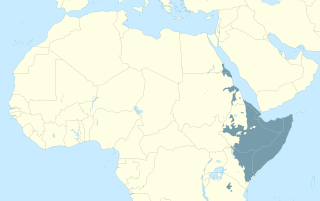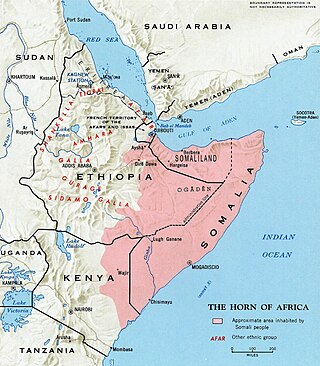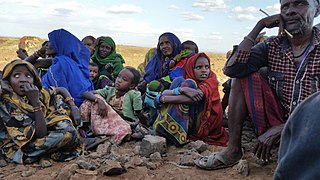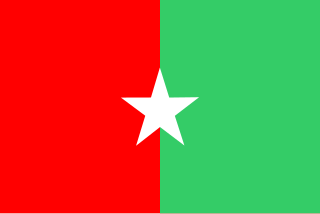
The Cushitic languages are a branch of the Afroasiatic language family. They are spoken primarily in the Horn of Africa, with minorities speaking Cushitic languages to the north in Egypt and Sudan, and to the south in Kenya and Tanzania. As of 2012, the Cushitic languages with over one million speakers were Oromo, Somali, Beja, Afar, Hadiyya, Kambaata, and Sidama.

The Horn of Africa (HoA), also known as the Somali Peninsula, is a large peninsula and geopolitical region in East Africa. Located on the easternmost part of the African mainland, it is the fourth largest peninsula in the world. It is composed of Somalia, Djibouti, Ethiopia, and Eritrea. Although not common, broader definitions include parts or all of Kenya and Sudan. It has been described as a region of geopolitical and strategic importance, since it is situated along the southern boundary of the Red Sea; extending hundreds of kilometres into the Gulf of Aden, Guardafui Channel, and Indian Ocean, it also shares a maritime border with the Arabian Peninsula.

East Africa, also known as Eastern Africa or the East of Africa, is a region at the eastern edge of the African continent, distinguished by its geographical, historical, and cultural landscape. Defined in varying scopes, the region is recognized in the United Nations Statistics Division scheme as encompassing 18 sovereign states and 4 territories.

Somali is an Afroasiatic language belonging to the Cushitic branch. It is spoken primarily in Greater Somalia, and by the Somali diaspora as a mother tongue. Somali is an official language in both Somalia and Ethiopia, and serves as a national language in Djibouti, it is also a recognised minority language in Kenya. The Somali language is officially written with the Latin alphabet although the Arabic script and several Somali scripts like Osmanya, Kaddare and the Borama script are informally used.

The Somali Region, also known as Soomaali Galbeed and officially the Somali Regional State, is a regional state in eastern Ethiopia. Its territory is the largest after Oromia Region. The regional state borders the Ethiopian regions of Afar and Oromia and the chartered city Dire Dawa to the west, as well as Djibouti to the north, Somalia to the northeast, east and south; and Kenya to the southwest.

Greater Somalia sometimes also called Greater Somaliland is the geographic location comprising the regions in the Horn of Africa in which ethnic Somalis live and have historically inhabited.

The North Eastern Province is one of the former provinces of Kenya. It had a land area of 127,358.5 km2, with its capital at Garissa. The North Eastern Province was carved out of the then Northern Frontier District (NFD) prior to independence.

The Somali people are a Cushitic ethnic group native to the Horn of Africa who share a common ancestry, culture and history. The East Cushitic Somali language is the shared mother tongue of ethnic Somalis, which is part of the Cushitic branch of the Afroasiatic language family, and they are predominantly Sunni Muslim. Forming one of the largest ethnic groups on the continent, they cover one of the most expansive landmasses by a single ethnic group in Africa.

The Ajuran is a Somali clan, part of the Jambelle clan which itself belongs to the largest Somali clan-family — the Hawiye. Ajuran members largely inhabit Kenya as well as southern east Ethiopia; considerable numbers are also found in southern Somalia. Some Ajuran members are settled in Mogadishu.

The Rendille are a Cushitic ethnic group inhabiting the Eastern Province of Kenya.

The Garre are a prominent Somali clan that traces its lineage back to Samaale, who is believed to have originated from the Arabian Peninsula through Aqiil Abu Talib. The Garre clan is considered to be a sub-clan of the Digil-Rahanweyn clan family, which is part of the larger Rahanweyn clan. However, genealogically, they are descended from Gardheere Samaale. The Garre are also categorized as southern Hawiye as well.

The Dir is one of the largest and most prominent Somali clans in the Horn of Africa. They are also considered to be the oldest Somali stock to have inhabited the region. Its members inhabit Djibouti, Somalia, Ethiopia, and northeastern Kenya.

The Ogaden is one of the major Somali clans in the Horn of Africa.
The Sheekhaal, also known as Fiqi Cumar is a clan that inhabits Somalia, Ethiopia, Djibouti and with considerable numbers also found in the Northern Frontier District (NFD) in Kenya.

Aweer (Aweera), also known as Boni, is a Cushitic language of Eastern Kenya. The Aweer people, known by the arguably derogatory exonym Boni, are historically a hunter-gatherer people, traditionally subsisting on hunting, gathering, and collecting honey. Their ancestral lands range along the Kenyan coast from the Lamu and Ijara Districts into Southern Somalia's Badaade District.
The Somali languages form a group that are part of the Afro-Asiatic language family. They are spoken as a mother tongue by ethnic Somalis in Horn of Africa and the Somali diaspora. Even with linguistic differences, Somalis collectively view themselves as speaking dialects of a common language.

Amud or Amoud is an ancient, ruined town in the Awdal region of Somaliland. Named after its patron Saint Amud it was a center of activity during the Golden Age of the Adal Kingdom. The archaeological site is situated 1,000 metres (3,300 ft) above sea level, around 10 km southeast of the regional capital Borama. Archaeologist Jorge Rodriguez states that this town, similar to other ruins in the area, originates from the 15th century and is associated with the Adal Sultanate.

The Proto-Afroasiatic homeland is the hypothetical place where speakers of the Proto-Afroasiatic language lived in a single linguistic community, or complex of communities, before this original language dispersed geographically and divided into separate distinct languages. Afroasiatic languages are today mostly distributed in parts of Africa, and Western Asia.

The predominant religion in Somalia is Islam, with tiny minorities of Christians, traditional African religions and others.

Kenyan Somalis are citizens and residents of Kenya who are of Somali ethnic descent. They have historically inhabited the North Eastern Province, previously called the Northern Frontier District, which was carved out of the Jubaland region of present-day southern Somalia during the colonial period. Following the civil war in Somalia that broke out in 1991, many Somalis sought asylum in the Somali-inhabited enclaves of Kenya. An entrepreneurial community, they established themselves in the business sector, particularly in the Nairobi suburb of Eastleigh.